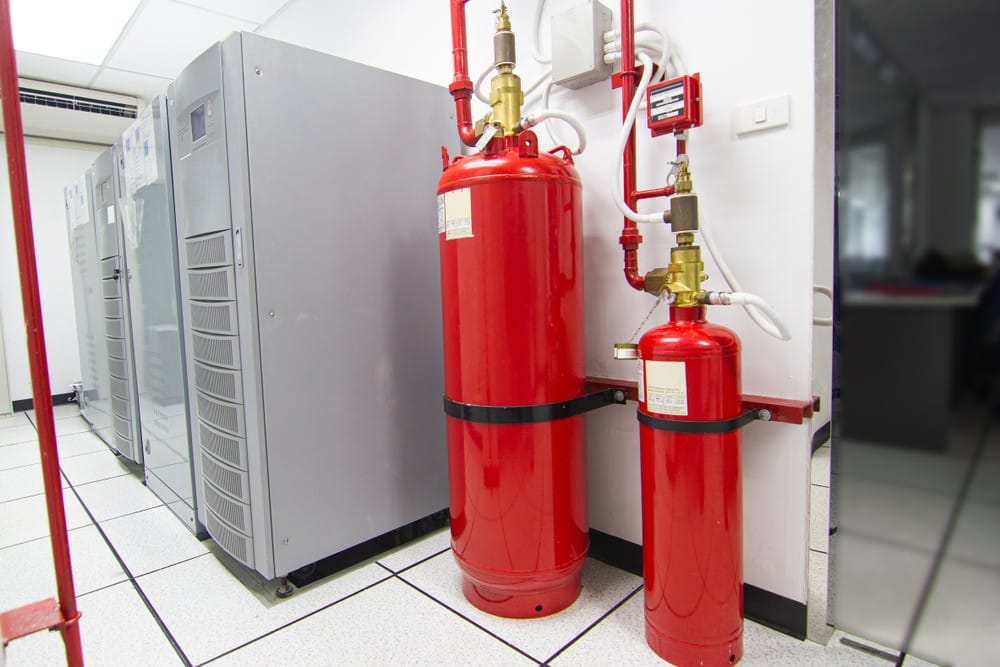This is the first of our four-part series on clean agent fire suppression systems. This series aims to educate organizations on various types of special fire hazard solutions (FM-200, ANSUL INERGEN, 3M Novec 1230, and different types of CO2), helping them to gain a better understanding of the best option for their facility.
Clean Agent Series: FM-200
Your fire suppression system shouldn’t cause more damage than the fire itself. This is a prevalent issue for industrial facilities that house extremely sensitive and/or high-value assets.
The solution? Clean agents. Clean agents are fire extinguishing materials that are electrically non-conducting, volatile, or gaseous, and that don’t leave residue upon evaporation.
Below, we’ll explore one of the most common clean agents: FM-200. We’ll talk about its fire extinguishing properties, its current phasedown, and viable clean agent alternatives to replace it.
What is FM-200?
FM-200 is a clean agent fire suppressant for Class A, B, and C fires. It’s a colorless, non-toxic gas that leaves no residue. For these reasons, it’s an ideal solution for protecting high-value assets in areas that are occupied and in locations where the cleanup of other agents is problematic.
Here’s how FM-200 works:
A fire can only occur when three elements are present: heat, oxygen, and a fuel source. Therefore, in order for any clean agent to effectively quench a fire, it must disrupt at least one component of this “fire triangle.” FM-200’s primary extinguishing mechanism is heat absorption, which means it removes the element of heat from the triangle.
FM-200 has been used across many different industries, but since it leaves no residue and is non-toxic to humans, it’s especially common in the following facilities:
- Bank vaults
- Data centers
- Telecommunications centers
- Flammable liquid storage
- Rare book stores
- Libraries
- Museums
New Government Regulations Regarding FM-200
In late 2020, the American Innovation and Manufacturing (AIM) Act was passed. This law is focused on regulating Hydrofluorocarbon gasses (HFCs), which are a specific chemistry of gasses used in some fire suppression clean agents — the most notable being FM-200.
Administered and enforced by the United States Environmental Protection Agency (EPA), the AIM Act requires a phasedown in the use of HFCs, and therefore in the use of FM-200.
About the FM-200 Phasedown
So, what does this FM-200 phasedown really mean for facilities across the country? Here’s the breakdown.
The FM-200 phasedown began on January 1, 2022. However, it’s important to note that this is a phasedown, not a phaseout. The goal is to reduce the production and consumption of HFCs, which means slowly but surely HFCs will become significantly less available and more expensive.
The AIM Act outlines an HFC phasedown schedule. In 2022, the goal is to reduce HFC production to 90% of the baseline amount. By 2024, the goal is to reduce HFC production to 60% of the baseline amount. At that point, there will be more reductions every few years until reaching just 15% of baseline production in 2036.
This means that if your facility is looking to install a new clean agent system, FM-200 won’t be an option anymore. And if your facility already has an FM-200 system installed, you may have limited time with it. Service parts and refills will still be available as the system deploys, but you may find yourself paying more for them due to limited availability. And eventually, when it’s time for a system upgrade, you’ll be in the market for something new.
FM-200 Clean Agent Replacement Options
All that said, if your facility currently has a FM-200 clean agent system, it’s time to consider other options. Luckily, there are plenty of them out there. At Vanguard Fire & Security Systems, we offer all of the following:
- ANSUL INERGEN
- 3M Novec 1230
- High-Pressure CO2
- Mini-Bulk Low-Pressure CO2
- Bulk Low-Pressure CO2
- Water Mist
While each of these are effective clean agent fire suppression solutions, there may be one that’s more suitable for your facility and application. It’s best to consult a fire protection specialist to ensure you’re making the right switch.
Need help replacing your FM-200 system? Vanguard Fire & Security Systems can help. Our experts are informed on the latest phasedown regulations and can help you find a clean agent alternative that will work best for your facility. Contact us online to get started.


